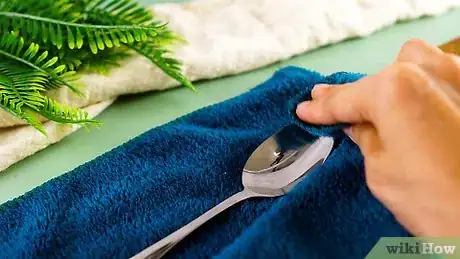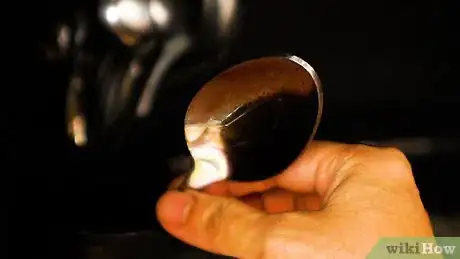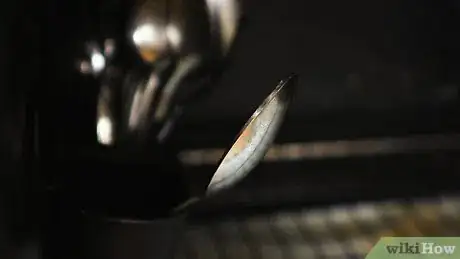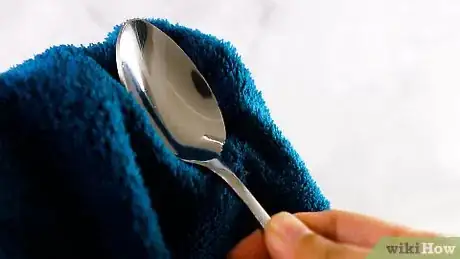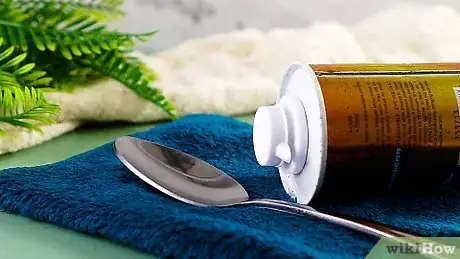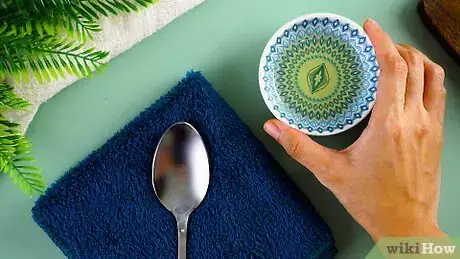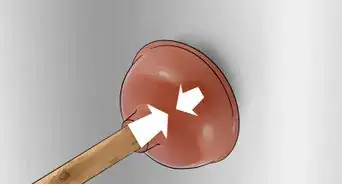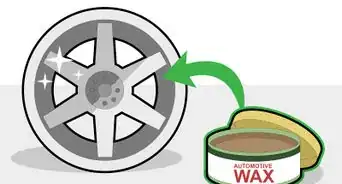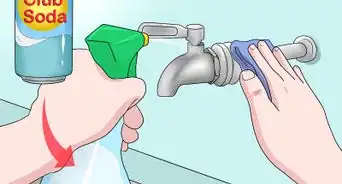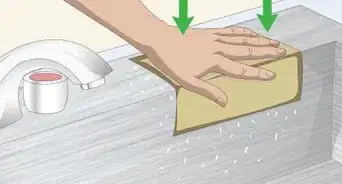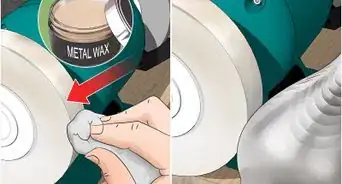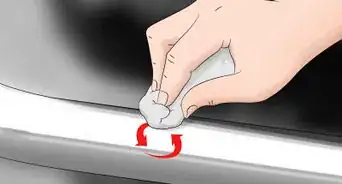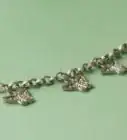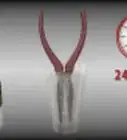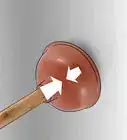This article was co-authored by Amy Mikhaiel. Amy Mikhaiel is a cleaning guru and the CEO of Amy's Angels Cleaning Inc., a residential and commercial cleaning company in Los Angeles, California. Amy's Angels was voted Best Cleaning Service by Angie’s Lists in 2018 and was the most requested cleaning company by Yelp in 2019. Amy's mission is to help women achieve their financial goals by establishing empowerment through cleaning.
This article has been viewed 385,092 times.
Stainless steel cutlery, as its name might suggest, is a special kind of metal that doesn't easily break down, rust, or stain. However, with use or over time, your stainless steel utensils will likely become dirty and tarnished, losing their shine and clean appearance. To clean your cutlery, you could make use of your dishwasher, or you might have to use manual methods to break up stubborn stains and buildup. After that, with a little extra effort, you can bring out a like-new shine in your utensils.
Steps
Removing Stubborn Stains and Buildup
-
1Create your cleaning solution. In a small saucer, dish, bowl, or container, mix baking soda and liquid dish soap until the two form a paste. This combination is excellent for breaking up tough dirtiness and difficult stains.
- A little bit goes a long way, and you can always mix more, so you may want to prepare a small amount first to prevent any going to waste.
- Use your finger or a stirring tool, like a spoon, to thoroughly mix the baking soda and soap until the paste is consistent throughout.[1]
-
2Apply the cleaning paste to your cutlery. You may want to clean your cutlery one at a time to ensure nothing is missed, or you may want to do all of it at once to save time. Gently scrub your paste into dirty areas with a nylon scrubber or a soft bristle brush to break up gunk and dirtiness.[2]
- If you're trying to save time by cleaning your cutlery in a large batch, you may want to use a tub or bucket to hold silverware and contain your cleaning paste.
- Using this special cleaning paste is especially useful for removing scorch marks and dark spots from your cutlery. However, it may take some time and effort before the mark is removed.
Advertisement -
3Spot clean remaining stains. Even after your thorough cleaning with your baking soda/dish soap paste, some stains might remain on your cutlery. If this is the case for you, use a clean nylon scrubber or soft bristle brush to scrub these away with undiluted white vinegar.[3]
- The surface of your stainless steel utensils can become scratched and cloudy over time by abrasive cleaning tools. Even when using a nylon scrubber or soft bristle brush, clean dirty areas gently.[4]
-
4Rinse your cleaned cutlery and dry it. After all remaining food, stains, and other dirtiness have been removed, you're nearly done. Rinse your cutlery under water and then use a soft, dry dishcloth to wipe away excess moisture, as hand drying will help prevent the formation of spots.
- If, over the course of your drying, your towel has become especially wet, swap this out with a new one that's clean and dry.
Using a Dishwasher
-
1Pre-clean your cutlery. Throwing your cutlery straight into the dishwasher can sometimes cause stubborn bits of food or sauce to cake onto it. You can prevent this from happening by lightly cleaning silverware before putting it into the dishwasher. Using dish soap and hot water:
- Thoroughly clean the cutlery. Avoid using abrasive scrubbers or brushes, as these can scratch the finish of your stainless steel. A soft dishcloth or sponge, however, is fine.
- Pay special attention to cracks, crevices, and other places food easily builds up when cleaning, including the tines of forks and the bowls of spoons.
EXPERT TIPAmy Mikhaiel is a cleaning guru and the CEO of Amy's Angels Cleaning Inc., a residential and commercial cleaning company in Los Angeles, California. Amy's Angels was voted Best Cleaning Service by Angie’s Lists in 2018 and was the most requested cleaning company by Yelp in 2019. Amy's mission is to help women achieve their financial goals by establishing empowerment through cleaning.House Cleaning Professional
 Amy Mikhaiel
Amy Mikhaiel
House Cleaning ProfessionalIf your cutlery is rusted, you can't use them any longer. It's hard to tell the difference between stains and rust, but if your cutlery is rusted, you can't clean them, and it's not safe to use them any longer.
-
2Place your cutlery into the dishwasher. Choose the setting on your dishwasher that best reflects the condition of your cutlery. In most cases, a normal cycle should be sufficient, but especially dirty flatware might require a heavy cycle. Turn off the drying cycle, if you are able. Then add a suitable detergent to your dishwasher, close its door, then start the washing cycle.
- To make it easier to return the cutlery to its place in your kitchen, you may want to separate your spoons, forks, and knives in your dishwasher.
- Some cutlery, especially certain kinds of spoons, can nest together in your dishwasher, making them difficult for your dishwasher to clean. You may want to spread out utensils like this, so your dishwasher can work most effectively.
-
3Run additional cycles as necessary. Stainless steel sometimes requires several wash cycles before it is completely clean. Older dishwashers and severely dirty cutlery, especially, might require a second run through the dishwasher.
- Inspect your cutlery after each cycle for remaining food, stains, or dirtiness. If you spot any, your utensils likely need a second cycle.
- Be careful when removing cutlery from your dishwasher to inspect it. Just after cleaning, the utensils can be very hot.
-
4Hand dry washed cutlery for best results. After your dishwasher's cleaning cycle is complete, remove your cutlery from it. Even if the cutlery is mostly dry, thoroughly wipe each utensil with a soft, dry cloth or a piece of paper towel. Drying by hand reduces spots left on your cutlery.
-
5Remove heat streaks or residual stains. Stainless steel cutlery can become streaked due to food stains or overexposure to heat. In most cases, these kinds of blemishes can be buffed away with a soft dishcloth or polishing cloth. You can add a polishing agent to improve the end polish, like:
- Olive oil, which will help remove streaks from cutlery. Use a soft dishcloth, rag, or paper towel moistened with olive oil to gently rub your cutlery with it to remove streaks.
- Mineral oil, much like olive oil, helps to reduce streaking. Moisten a soft dishcloth, rag, or paper toil with the oil, then gently rub the cutlery until streaks are gone.[5]
Bringing out the Shine in Your Cutlery
-
1Use a specially formulated polish. There are many different kinds of specially designed polishing agents for polishing stainless steel. You can often find products like these at your local grocery in the cleaning section, at hardware stores, general retailers, and online retailers.[6]
- You should follow the label instructions on your polish for best results. Generally, spray some polisher on a soft cloth and buff your cutlery until the metal is bright.
- Pay close attention to the warning on stainless steel polishers. Some formulas might not be intended for use on eating utensils.[7]
-
2Buff your cutlery with lemon oil, alternately. Lemon oil will not only bring out the shine in your stainless steel utensils, it will also leave behind the pleasing, refreshing scent of lemon. This common polishing agent can be found at most grocery stores and general retailers. To use lemon oil to polish your cutlery:
- Apply a small amount of the oil to a soft, dry cloth, like a dishtowel or clean rag. In a pinch, paper towel will also work for polishing.[8]
-
3Polish with the grain of the metal. Much like the grain of wood indicates the direction the wood appears to flow in, so too will your stainless steel cutlery have a grain. You can generally expect that the grain of stainless steel will either be vertical (up and down) or horizontal (left to right).
- Polishing with the grain of the metal with any polishing agent will improve the overall end appearance of your cutlery.[9]
Expert Q&A
Did you know you can get expert answers for this article?
Unlock expert answers by supporting wikiHow
-
QuestionWhat is the best cleaner for stainless steel?
 Amy MikhaielAmy Mikhaiel is a cleaning guru and the CEO of Amy's Angels Cleaning Inc., a residential and commercial cleaning company in Los Angeles, California. Amy's Angels was voted Best Cleaning Service by Angie’s Lists in 2018 and was the most requested cleaning company by Yelp in 2019. Amy's mission is to help women achieve their financial goals by establishing empowerment through cleaning.
Amy MikhaielAmy Mikhaiel is a cleaning guru and the CEO of Amy's Angels Cleaning Inc., a residential and commercial cleaning company in Los Angeles, California. Amy's Angels was voted Best Cleaning Service by Angie’s Lists in 2018 and was the most requested cleaning company by Yelp in 2019. Amy's mission is to help women achieve their financial goals by establishing empowerment through cleaning.
House Cleaning Professional One cleaning option is to use baking soda and aluminum foil. Add water and two spoonfuls of baking soda to a large pot and then place folded pieces of aluminum foil inside. Boil the water and put your stainless steel pieces in the water. The stains will start disappearing. Afterward, use warm water and soap to wash them like normal.
One cleaning option is to use baking soda and aluminum foil. Add water and two spoonfuls of baking soda to a large pot and then place folded pieces of aluminum foil inside. Boil the water and put your stainless steel pieces in the water. The stains will start disappearing. Afterward, use warm water and soap to wash them like normal. -
QuestionI tested a new stainless steel cheese knife against the side of an uncut round of French Camembert and now it has indelible marks on its blade! None of the usual techniques are working, what can I do?
 Community AnswerUse a liquid or paste Stainless Steel Cleaner on the discolored area and rub it with a cloth or sponge and that should remove it. You may have to leave the cleaner on for a few minutes if the spot is not first removed.
Community AnswerUse a liquid or paste Stainless Steel Cleaner on the discolored area and rub it with a cloth or sponge and that should remove it. You may have to leave the cleaner on for a few minutes if the spot is not first removed. -
QuestionOur stainless steel utensils are turning grey. Can they be restored?
 Community AnswerAdd a small amount of bleach, about 1/4 cup, to one gallon of hot soapy water and let them soak for about 10 minutes. Then wash and dry.
Community AnswerAdd a small amount of bleach, about 1/4 cup, to one gallon of hot soapy water and let them soak for about 10 minutes. Then wash and dry.
Warnings
- Use extra caution when cleaning silver-plated stainless steel cutlery. Silver plating interacts differently with detergents. Using the wrong one can cause permanent damage to your cutlery's finish. Use specialized formulas intended for silver-plated stainless steel.⧼thumbs_response⧽
- Avoid using abrasives, like a steel wool and scrubbing pads, solutions containing chlorine bleach or chloride, and refrain from using hard water, as all of these could negatively impact the finished result of your cutlery cleaning.⧼thumbs_response⧽
- Some cleaners or polishers may damage the finish of your cutlery. If you are unsure about of one of these, test a small, unnoticeable part of the silverware first.⧼thumbs_response⧽
- Although it's likely that your stainless steel cutlery is dishwasher safe, for the best results from your cleaning, wash your cutlery by hand.⧼thumbs_response⧽
References
- ↑ http://www.bobvila.com/articles/how-to-clean-stainless-steel/
- ↑ http://www.bobvila.com/articles/how-to-clean-stainless-steel/
- ↑ https://www.thekitchn.com/how-to-clean-stainless-steel-appliances-with-vinegar-and-oil-cleaning-lessons-from-the-kitchn-205232
- ↑ http://www.bobvila.com/articles/how-to-clean-stainless-steel/
- ↑ https://www.thekitchn.com/how-to-clean-stainless-steel-appliances-with-vinegar-and-oil-cleaning-lessons-from-the-kitchn-205232
- ↑ http://www.bobvila.com/articles/how-to-clean-stainless-steel/
- ↑ http://www.quickanddirtytips.com/house-home/housekeeping/how-to-clean-stainless-steel?page=2
- ↑ http://www.bobvila.com/articles/how-to-clean-stainless-steel/
- ↑ https://www.thekitchn.com/how-to-clean-stainless-steel-appliances-with-vinegar-and-oil-cleaning-lessons-from-the-kitchn-205232
About This Article
To clean stainless steel cutlery, start by mixing baking soda and dish soap in a container to form a paste. Then, cover your cutlery in the paste and scrub dirty areas with a scrubber or a brush. If you still spot some stains after cleaning the cutlery with the paste, spot clean them with some undiluted white vinegar and a brush. Finish by rinsing your cutlery under clean water and drying it with a towel. For tips on how to make your stainless steel cutlery shine with polish, read on!
